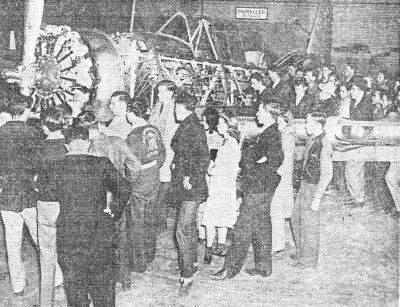 |
Air Scouts
Shown to the left is a photo of the Air Scouts in a hanger at Goodfellow Field in San Angelo. The caption under the photo said "Air Scouts and other members of the San Angelo High School pre-flight class are pictured during their inspection trip at Goodfellow Field Thursday. They are pictured with a stripped-down BT-13A training plane in the Sub-Depot hanger." (2/28/43) The Air Scout program was an entirely new part of the Boy Scout program at the time, designed for boys 15 years of age and older who were interested in any of the 49 phases of aeronautics. The Air Scouts were to be operated with the Aeronautics Club of the high school. The new group was endorsed by the Army Air Forces General Staff, and covers all phases of the aviation field except actual flight. R. W. Emerson, aeronautics Instructor, was the squadron leader. The group will be the largest single senior unit in the Concho Valley Council. The first official meeting of the group was held January 5, 1943. Group leaders, who were designated as flight pilots, were to be selected at their first meeting. The program had the support of Supt. Bryan Dickson and Principal John Rowntree. There were 48 charter members
of the squadron which included M. D. Taff, P. M. Maddox, G. D. Westbrook,
E. V. White, John Brazier, S. D. Callison, W. U. Chandler, John A. McMillan,
Glen Zentner, Martin Melton, Gene Davis, Bobby Thompson, Norman McCaulskey,
L. M. Haskins, Hal Ragsdale, Darwin Talafuse, Frank Coraces, Charles Smith,
J. C. Gotcher, Robert M. Green, Robert W. Gerber, Al. L. Lee, E. F. Taylor,
T. G. Zentner and J. D. Duke.
Six San Angelo Air Scouts from Troop 7, which was formerly called the Zocahs, participated in a Region 9, Air Scout Encampment held at Perrin Field between Denison and Sherman, June 10-15, 1946. The Air Scouts observed the Army Air Force in action, lived in Army barracks and in general learned about the AFF. Those attending from San Angelo were Johnny Lee Grissom, Connie Robertson, William S. Gill, Jimmie Powell, Benjie Bowman and Britton Smith. Doolittle BombsightIn the February 8, 1949, Boy Scout Edition in the San Angelo Standard-Times, only Squadron 7 of San Angelo, 28 members and Squadron 84 of Sabinal, 15 members, were listed among the council units. However, in "The Spur,"
a publication of the Concho Valley Council, a story appeared that said
that Arias Carr was elected squadron leader, when J. B. Morris, went to
Eldorado to aid in the organizing of a squadron there. Mr. Car was
a pilot in World War II, and his assistant, William Pat Patterson, a Senior
Scout Commissioner, had his own plane and had done quite a bit of flying.
Ten Senior Scouts were counted as charter members. The squadron was
sponsored by the Lions Club of Eldorado.
Air Scouts - Comanche Trail CouncilSquadron 63 was organized on January 8, 1946 and was sponsored by Breckenridge Rotary Club. Jackson Nesbitt was the first Squadron Leader and they chartered with fifteen youth. By the end of the year they had twenty-six boys registered in the unit. This Squadron was active as a unit until February 1954. Another group, Squadron 72, was organized a year after Squadron 63 in March of 1947. They were sponsored by the American Legion of Brownwood with Alva White as their Squadron Leader. However, this unit failed to recharter the follow year. To our knowledge, no boy
in these two units earned the highest award in Air Scouts, the Ace Award.
Air Scouts - Chisholm Trail Council"The first major project undertaken by the Air Scout Squadron was erecting the air markers for the City of Abilene. The skymarking program was sponsored by both the Senior and Junior Chamber of Commerce, Aviation Committees. In most places they used rocks, that were later whitewashed. Captain Wayne Hall flew over the area and located the most desirable spots, then the scouts went to work. The Abilene Reporter states that the Air Scout Squadron erected Abilene's first airmarker for the Wright Skyway, originally designated as United States Skyway number one. It was set up on a mountain top eight miles south of Merkel and about ten miles west of Camp Barkeley. The marker was built in the shape of an airplane. The wings measured twenty-six feet from tip to tip and had 'Skyway' painted on them. The wings pointed east and west, indicating the direction of the route." This was quoted from Claude Olen Willis's "A History of Chisholm Trail Council Boy Scouts of America." Updated: February 27, 2004 Return to Home Page |
 The
first Air Scout Squadron in West Texas was organized in 1942 during World
War II in San Angelo, Texas. The Air Scouts, Squadron No. 1, was
organized in December among students of preflight aeronautics at San Angelo
High School.. The Concho Valley Council, under the leadership of Don C.
Baldwin, Scout Executive, were to secure expert counselors to assist in
aeronautics, airplane design, airplane structure, weather, radio, electricity,
mechanical drawing and photography.
The
first Air Scout Squadron in West Texas was organized in 1942 during World
War II in San Angelo, Texas. The Air Scouts, Squadron No. 1, was
organized in December among students of preflight aeronautics at San Angelo
High School.. The Concho Valley Council, under the leadership of Don C.
Baldwin, Scout Executive, were to secure expert counselors to assist in
aeronautics, airplane design, airplane structure, weather, radio, electricity,
mechanical drawing and photography.